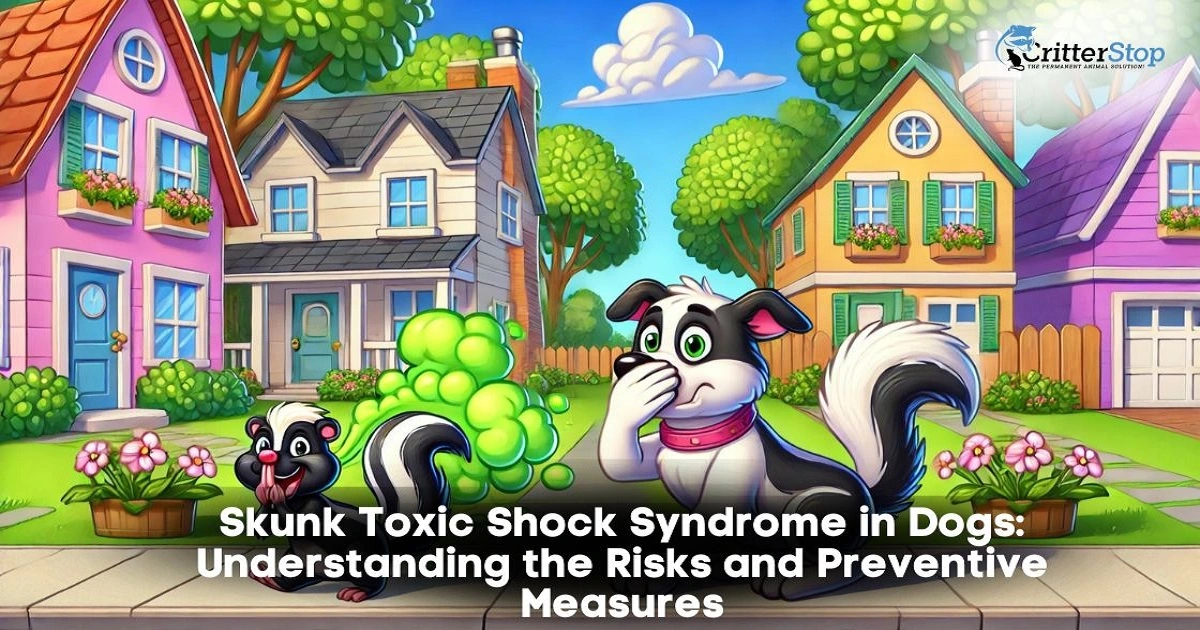
One of the less commonly discussed hazards of pet ownership is the potential for skunk toxic shock syndrome (STSS) in dogs. While skunks are notorious for their unpleasant odor, they can also pose a serious health risk to our canine companions. This article aims to provide a comprehensive overview of STSS, exploring its causes, symptoms, treatment, and preventive strategies.

Skunk toxic shock syndrome is a rare but potentially fatal condition that occurs when a dog is sprayed by a skunk. The spray contains a mixture of sulfur-containing chemicals known as thiols and thioacetates. When these compounds enter a dog's bloodstream through mucous membranes or broken skin, they can trigger a severe systemic reaction.
The primary cause of STSS is exposure to skunk spray. Skunks spray as a defense mechanism when they feel threatened, and the spray can travel up to 15 feet. The chemical composition of skunk spray includes:
Recognizing the symptoms of STSS is crucial for prompt treatment. Symptoms may appear within minutes to hours after exposure and can include:
If your dog is sprayed by a skunk, immediate action is essential to mitigate the risk of STSS. Follow these steps:

Veterinarians diagnose STSS based on the dog's symptoms and history of skunk exposure. Blood tests are essential to assess the extent of hemolysis and anemia. Treatment focuses on supportive care and may include:
Preventing skunk exposure is the best way to protect your dog from STSS. Consider the following preventive measures:
After an episode of STSS, long-term health monitoring is crucial. Regular veterinary check-ups and blood tests can help ensure your dog’s recovery and detect any lingering effects. Some dogs may experience chronic health issues related to anemia and oxidative damage, necessitating ongoing medical care.
To better understand the impact of skunk toxic shock syndrome (STSS) in dogs, let’s delve into some real-life examples and case studies. These stories highlight the importance of quick action and proper veterinary care.
Max, a three-year-old Labrador Retriever, played in his backyard one evening when he startled a skunk. Within seconds, the skunk sprayed Max directly in the face. Max’s owner, Sarah, immediately noticed the strong odor and rushed to bring him inside.
Sarah followed the recommended decontamination steps by applying a hydrogen peroxide, baking soda, and dish soap solution before rinsing Max thoroughly. Despite her quick action, Max began to show signs of lethargy and vomiting within an hour.
Sarah contacted her veterinarian, who advised bringing Max in for an emergency visit. At the clinic, Max was diagnosed with STSS and received intravenous fluids, oxygen therapy, and close monitoring. Thanks to Sarah’s prompt response and the veterinarian’s expertise, Max fully recovered.
Bella, a five-year-old Golden Retriever, had a less fortunate encounter with a skunk during a camping trip. Bella was sprayed late at night, and her owners, unfamiliar with the dangers of skunk spray, attempted to wash her off with water.
This mistake activated the thioacetates, worsening Bella’s condition. By morning, Bella was experiencing severe symptoms, including convulsions and difficulty breathing. Her owners rushed her to the nearest veterinary hospital, where she was diagnosed with severe STSS.
Bella required extensive treatment, including blood transfusions and prolonged oxygen therapy. While Bella survived, she suffered from long-term health issues related to anemia and organ damage.
These cases underscore the importance of educating pet owners about the risks of skunk encounters and the proper steps to take if a dog is sprayed. Veterinarians and pet care professionals play a vital role in disseminating this information. Community awareness programs, informative brochures, and online resources can help spread the word about STSS and preventive measures.
Ongoing research into the chemical composition of skunk spray and its effects on dogs is essential for developing better treatment protocols and preventive measures. Veterinary researchers are exploring new antioxidant therapies and supportive treatments to improve recovery outcomes for dogs affected by STSS. Additionally, advancements in diagnostic techniques can help veterinarians identify and treat STSS more effectively.

Collaboration between pet owners, veterinarians, and wildlife control experts is crucial for preventing skunk encounters and protecting dogs from STSS. Wildlife control services can assist in identifying and addressing skunk activity in residential areas. By working together, communities can create safer pet environments and reduce the risk of skunk encounters.
While skunks are often viewed as nuisances due to their spray, they play a significant role in the ecosystem. Skunks help control insect and rodent populations, contributing to a balanced environment. Understanding their behavior and habitat can help pet owners proactively avoid encounters without resorting to harmful measures against skunks.
By staying informed and prepared, pet owners can protect their dogs from the dangers of skunk toxic shock syndrome and ensure their well-being.
Professional wildlife removal services are essential to mitigate the risk of skunk encounters for those living in the North Texas area. Critter Stop, a humane wildlife removal company, offers expert services to help keep your property free from wildlife threats.
With a fantastic reputation and outstanding customer reviews, Critter Stop is known for providing high-quality work and excellent customer service. If you are facing issues with skunks or other wildlife, don’t hesitate to call Critter Stop at (214) 234-2616 for a free inspection and effectively solve your wildlife or pest removal problems.
We address common concerns about skunk encounters with dogs, drawing from our expertise at Critter Stop, a leading pest control company in North Texas.
Skunk toxic shock syndrome (STSS) is a rare but potentially fatal condition that occurs when a dog is sprayed by a skunk. The spray contains a mixture of sulfur-containing chemicals known as thiols and thioacetates. These compounds can enter a dog's bloodstream through mucous membranes or broken skin, leading to severe systemic reactions such as hemolysis, respiratory distress, and convulsions. Immediate veterinary care is crucial to manage the symptoms and prevent complications.
The duration a dog will smell like a skunk can vary, but typically, the odor can last for several days to a few weeks if not properly treated. Skunk spray contains volatile compounds that are particularly difficult to remove. Immediate decontamination using hydrogen peroxide, baking soda, and liquid dish soap solution can help neutralize the odor effectively. However, traces of the smell might linger and require multiple treatments to fully eliminate.
Yes, skunk spray can be harmful to dogs. Besides the unpleasant odor, skunk spray can cause a range of health issues in dogs, including nausea, vomiting, and temporary blindness if it gets into their eyes. In severe cases, dogs can develop skunk toxic shock syndrome (STSS), which involves symptoms like lethargy, anemia, and respiratory distress. It's important to rinse the dog immediately and seek veterinary care to mitigate these health risks.
If a dog gets sprayed by a skunk, the owner should take immediate action to minimize the impact. First, avoid rinsing the dog with water as it can worsen the smell. Instead, apply a mixture of hydrogen peroxide (3%), baking soda, and liquid dish soap to the affected areas, avoiding the eyes and mouth. Rinse thoroughly after applying the solution. It's also crucial to contact a veterinarian promptly to monitor for symptoms of skunk toxic shock syndrome and receive appropriate care.
Skunk spray can cause chronic health issues in dogs if not treated properly. Dogs may suffer from lingering odors and skin irritation. More seriously, if skunk toxic shock syndrome occurs, it can lead to long-term complications such as anemia and organ damage. Continuous veterinary check-ups and monitoring are recommended to ensure the dog's full recovery and address any potential long-term effects.
Yes, skunk spray can make a dog sick. Immediate reactions often include nausea, vomiting, and drooling. The spray can also irritate the eyes, leading to temporary blindness. In severe cases, dogs can develop skunk toxic shock syndrome (STSS), which manifests as more severe symptoms like lethargy, anemia, and respiratory distress. Prompt and thorough decontamination, followed by veterinary care, is essential to prevent serious health issues.
Visit our Critter Library and learn more about our furry friends







